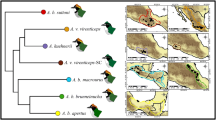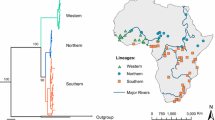Abstract
Using a species distribution model, we reconstructed the environmental niches of Antirrhinum majus pseudomajus and Antirrhinum majus striatum, two closely related species with parapatric distributions. We tested whether retention of ancestral environmental niche (i.e. niche conservatism) or adaptation to different ecological conditions (i.e. niche divergence) could explain the maintenance of their non-overlapping geographic ranges. We found that the environmental niche of A. m. pseudomajus is almost twice as large as that of A. m. striatum, with substantial overlap indicating that A. m. pseudomajus and A. m. striatum should co-occur frequently within the geographic range of A. m. striatum. By analysing contact zones where both subspecies are geographically close, we found that the presence of one subspecies instead of the other was significantly influenced by particular combinations of climatic factors. Since independent genetic evidence indicates that the two subspecies have experienced phases of range overlap at or near contact zones over the course of their evolutionary history, we propose that ecological niche displacement might be an important factor in explaining the absence of current range overlap between A. majus subspecies.




Similar content being viewed by others
References
Andalo C, Cruzan MB, Cazettes C et al (2010) Post-pollination barriers do not explain the persistence of two distinct Antirrhinum subspecies with parapatric distribution. Plant Syst Evol 286:223–234
Anderson S, Evensen MK (1978) Randomness in allopatric speciation. Syst Zool 27:421–430
Araujo MB, Pearson RG, Thuiller W, Erhard M (2005) Validation of species-climate impact models under climate change. Glob Chang Biol 11:1504–1513
Brown WL, Wilson EO (1956) Character displacement. Syst Zool 5:49–64
Buermann W, Saatchi S, Smith TB et al (2008) Predicting species distributions across the Amazonian and Andean regions using remote sensing data. J Biogeogr 35:1160–1176
Bull CM (1991) Ecology of parapatric distributions. Annu Rev Ecol Syst 22:19–36
Cicero C (2004) Barriers to sympatry between avian sibling species (Paridae: Baeolophus) in local secondary contact. Evolution 58:1573–1587
Connor EF, Bowers MA (1987) The spatial consequences of interspecific competition. Ann Zool Fennici 24:213–226
Currat M, Ruedi M, Petit RJ, Excoffier L (2008) The hidden side of invasions: massive introgression by local genes. Evolution 62:1908–1920
Dayan T, Simberloff D (2005) Ecological and community-wide character displacement: the next generation. Ecol Lett 8:875–894
Dobzhansky T (1951) Genetics and the origin of species. Columbia University Press, New York
Elith J, Graham CH, Anderson RP et al (2006) Novel methods improve prediction of species’ distributions from occurrence data. Ecography 29:129–151
Fielding AH, Bell JF (1997) A review of methods for the assessment of prediction errors in conservation presence/absence models. Environ Conserv 24:38–49
Funk DJ (1998) Isolating a role for natural selection in speciation: host adaptation and sexual isolation in Neochlamisus bebbianae leaf beetles. Evolution 52:1744–1759
Garcia-Ramos G, Sanchez-Garduno F, Maini PK (2000) Dispersal can sharpen parapatric boundaries on a spatially varying environment. Ecology 81:749–760
Graham CH, Ron SR, Santos JC, Schneider CJ, Moritz C (2004) Integrating phylogenetics and environmental niche models to explore speciation mechanisms in dendrobatid frogs. Evolution 58:1781–1793
Grenouillet G, Buisson L, Casajus N, Lek S (2010) Ensemble modelling of species distribution: the effects of geographical and environmental ranges. Ecography 34:9–17
Guisan A, Thuiller W (2005) Predicting species distribution: offering more than simple habitat models. Ecol Lett 8:993–1009
Hijmans RJ, Cameron SE, Parra JL, Jones PG, Jarvis A (2005) Very high resolution interpolated climate surfaces for global land areas. Int J Climatol 25:1965–1978
Holt RD (2003) On the evolutionary ecology of species’’ ranges. Evol Ecol Res 5:159–178
Hutchinson GE (1953) The concept of pattern of ecology. Proc Acad Nat Sci Phila 105:1–12
Justice CO, Vermote E, Townshend JRG et al (1998) The moderate resolution imaging spectroradiometer (MODIS): land remote sensing for global change research. IEEE Transact Geosci Remote 36:1228–1249
Khimoun A, Burrus M, Andalo C et al (2011) Locally asymmetric introgressions between subspecies suggest circular range expansion at the Antirrhinum majus global scale. J Evol Biol 24:1433–1441
King M (1993) Species evolution: the role of chromosome change. Cambridge University Press, Cambridge
Kozak KH, Graham CH, Wiens JJ (2008) Integrating GIS-based environmental data into evolutionary biology. Trends Ecol Evol 23:141–148
Kremen C, Cameron A, Moilanen A et al (2008) Aligning conservation priorities across taxa in Madagascar with high-resolution planning tools. Science 320:222–226
Losos JB (2000) Ecological character displacement and the study of adaptation. Proc Natl Acad Sci USA 97:5693–5695
McCormack JE, Zellmer AJ, Knowles LL (2010) Does niche divergence accompany allopatric divergence in Aphelocoma jays as predicted under ecological speciation? insights from tests with niche models. Evolution 64:1231–1244
Miller RS (1967) Pattern and process in competition. Adv Ecol Res 4:1–74
Nakazato T, Bogonovich M, Moyle LC (2008) Environmental factors predict adaptive phenotypic differentiation within and between two wild Andean tomatoes. Evolution 62:774–792
Pearson RG, Dawson TP, Liu C (2004) Modelling species distributions in Britain: a hierarchical integration of climate and land-cover data. Ecography 27:285–298
Pearson RG, Raxworthy CJ, Nakamura M, Peterson AT (2007) Predicting species distributions from small numbers of occurrence records: a test case using cryptic geckos in Madagascar. J Biogeogr 34:102–117
Peterson AT, Soberon J, Sanchez-Cordero V (1999) Conservatism of ecological niches in evolutionary time. Science 285:1265–1267
Phillips SJ, Anderson RP, Schapire RE (2006) Maximum entropy modeling of species geographic distributions. Ecol Model 190:231–259
R Development Core Team (2008) R: a language and environment for statistical computing. R Foundation for Statistical Computing, Vienna, Austria
Ricklefs RE (2010) Evolutionary diversification, coevolution between populations and their antagonists, and the filling of niche space. Proc Natl Acad Sci USA 107:1265–1272
Rundle HD, Nosil P (2005) Ecological speciation. Ecol Lett 8:336–352
Schluter D (2001) Ecology and the origin of species. Trends Ecol Evol 16:372–380
Schluter D (2009) Evidence for ecological speciation and its alternative. Science 323:737–741
Schoener TW (1968) The Anolis lizards of Bimini: resource partitioning in a complex fauna. Ecology 49:704–726
Sillero N (2011) What does ecological modelling model? A proposed classification of ecological niche models based on their underlying methods. Ecol Model 222:1343–1346
Warren DL, Glor RE, Turelli M (2008) Environmental niche equivalency versus conservatism: quantitative approaches to niche evolution. Evolution 62:2868–2883
Wiens JJ (2004) Speciation and ecology revisited: phylogenetic niche conservatism and the origin of species. Evolution 58:193–197
Wiens JJ, Graham CH (2005) Niche conservatism: integrating evolution, ecology, and conservation biology. Annu Rev Ecol Evol Syst 36:519–539
Wiens JA, Stralberg D, Jongsomjit D, Howell CA, Snyder MA (2009) Niches, models, and climate change: assessing the assumptions and uncertainties. Proc Natl Acad Sci USA 106:19729–19736
Acknowledgments
All the work presented in this article was supported by core funding from CNRS and the University of Toulouse Paul Sabatier, France. A. Khimoun and J. Cornault are supported by a PhD grant from the French ministry of research. We thank, Yann Bourgeois and Loïc Tudesque for technical help with GIS files. We thank Jérôme Chave, Jean-Baptiste Ferdy, and Ferran Palero for their useful comments on the manuscript. We also thank the associate editor Mario Vallejo-Marin and two anonymous reviewers for their useful suggestions. This work is part of the “Laboratoire d’Excellence (LABEX)” entitled TULIP (ANR-10-LABX-41).
Author information
Authors and Affiliations
Corresponding author
Additional information
A. Khimoun and J. Cornuault have contributed equally to this work and should be considered sharing first authorship.
Electronic supplementary material
Below is the link to the electronic supplementary material.
Rights and permissions
About this article
Cite this article
Khimoun, A., Cornuault, J., Burrus, M. et al. Ecology predicts parapatric distributions in two closely related Antirrhinum majus subspecies. Evol Ecol 27, 51–64 (2013). https://doi.org/10.1007/s10682-012-9574-2
Received:
Accepted:
Published:
Issue Date:
DOI: https://doi.org/10.1007/s10682-012-9574-2




